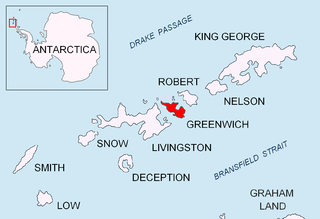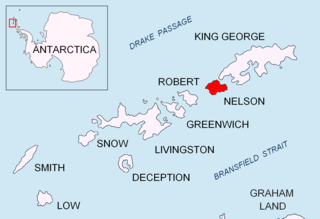
Danco Island or Isla Dedo is an island off Antarctica, 2 kilometres (1 nmi) long lying in the southern part of Errera Channel, off the west coast of Graham Land. It was charted by the Belgian Antarctic Expedition under Adrien de Gerlache, 1897–1899. Danco Island was surveyed by the Falkland Islands Dependencies Survey from Norsel in 1955, and named by the UK Antarctic Place-names Committee for Emile Danco (1869–1898), a Belgian geophysicist and member of the Belgian Antarctic Expedition, who died on board Belgica in the Antarctic.

The Dailey Islands are a group of small volcanic islands lying off the coast of Victoria Land, 9 kilometres (5 nmi) northeast of Cape Chocolate, in the northern part of the ice shelf bordering McMurdo Sound. They were discovered by the British National Antarctic Expedition, 1901–04, under Robert Falcon Scott, and named for Fred E. Dailey, the expedition carpenter.

The Windmill Islands are an Antarctic group of rocky islands and rocks about 11.1 kilometres (6 nmi) wide, paralleling the coast of Wilkes Land for 31.5 kilometres (17 nmi) immediately north of Vanderford Glacier along the east side of Vincennes Bay. Kirkby Shoal is a small shoal area with depths of less than 18 metres (59 ft) extending about 140 metres (459 ft) westwards and SSW, about 3.4 kilometres (2.1 mi) from the summit of Shirley Island, Windmill Islands, and 0.24 kilometres (0.15 mi) NW of Stonehocker Point, Clark Peninsula.

Liard Island is a mountainous island, 24 kilometres (13 nmi) long, 11 kilometres (6 nmi) wide and rising to 1,000 metres (3,300 ft), situated in the north-central portion of Hanusse Bay, off the west coast of Graham Land, Antarctica. It was discovered and named by the French Antarctic Expedition, 1908–10, under Jean-Baptiste Charcot.

The Ibar Rocks are two rocks located 0.4 kilometres (0.2 nmi) east of Bonert Rock and 1 kilometre (0.6 nmi) southeast of Canto Point, Greenwich Island, in the South Shetland Islands. The names "Islote Ibar" and "Islote Teniente Ibar" appearing on Chilean hydrographic charts in the 1950s refer to the larger and western rock. The recommended name "Ibar Rocks" includes a submerged outlier to the northeast of the larger rock. Teniente (lieutenant) Mario Ibar P. signed the official act of inauguration of the Chilean Captain Arturo Prat Base on Greenwich Island in 1947.

Anton Island is a low ice-capped island about 1 kilometre (0.5 nmi) long. It lies 9 kilometres (5 nmi) north-northeast of Lewis Island, just outside the east side of the entrance to Davis Bay. It was discovered in 1956 from the MV Kista Dan by an Australian National Antarctic Research Expedition led by Phillip Law that landed on the island on 18 January 1960, and was named by the Antarctic Names Committee of Australia for Anton Moyell, first officer on the MV Magga Dan in 1960.

Benton Island is an ice-covered island about 7 kilometres (4 nmi) long, lying 9 kilometres (5 nmi) northwest of Nolan Island in the Marshall Archipelago. It was mapped by the United States Geological Survey from surveys and from U.S. Navy air photos, 1959–65, and named by the Advisory Committee on Antarctic Names for William T. Benton, BM1, U.S. Navy, Boatswain's Mate aboard USS Glacier along this coast, 1961–62.

Borceguí Island is an ice-free island in the South Shetland Islands, midway between Cape Yelcho and the Gibbous Rocks, 2 kilometres (1 nmi) off the north coast of Elephant Island. The name was applied by the command of the Argentine sea-going tug Chiriguano in the 1954–55 cruise; in Spanish "borceguí" means half-boot and describes the shape of the island.

Carlson Island is a rocky island 2 kilometres (1 nmi) long and 300 metres (1,000 ft) high, lying in Prince Gustav Channel 6 kilometres (3 nmi) southeast of Pitt Point, Trinity Peninsula. It was discovered in 1903 by the Swedish Antarctic Expedition under Otto Nordenskiöld, who named it for Wilhelm Carlson, one of the chief patrons of the expedition.

Chameau Island is a rocky island 0.2 kilometres (0.1 nmi) long, lying 1.5 kilometres (0.8 nmi) east of Cape Découverte in the Curzon Islands. It was charted and named in 1951 by the French Antarctic Expedition. The name is suggestive of the island's form which resembles the two humps on a (bactrian) camel, "chameau" being a French word for camel.

Johnson Island is an ice-covered island, about 17 kilometres (9 nmi) long and 9 kilometres (5 nmi) wide, lying within the Abbot Ice Shelf, Antarctica, about 26 kilometres (14 nmi) southeast of Dustin Island. The feature was observed and roughly positioned as an "ice rise" by parties from the USS Glacier (AGB-4) in February 1961. It was remapped by the United States Geological Survey from U.S. Navy air photos, 1966, and was named by the Advisory Committee on Antarctic Names for Theodore L. Johnson, an electrical engineer at Byrd Station in 1964–65.

The Knight Rocks are a group of small rocks which lie 8 kilometres (4.5 nmi) west-northwest of the south end of Snow Island, in the South Shetland Islands. The rocks were so named by the UK Antarctic Place-Names Committee following a survey by Lieutenant Commander F.W. Hunt, Royal Navy, in 1951–52, because of their proximity to Castle Rock.

Grinder Island is one of the ice-covered islands in the Marshall Archipelago, located within the Sulzberger Ice Shelf off the coast of Marie Byrd Land, Antarctica. The island is 13 kilometres (7 nmi) long and 2 kilometres (1 nmi) wide and lies 24 kilometres (13 nmi) southwest of Steventon Island. It was mapped by the United States Geological Survey from surveys and U.S. Navy air photos, 1959–65, and was named by the Advisory Committee on Antarctic Names for Harry W. Grinder, a U.S. Navy aviation structural mechanic of McMurdo Station, 1967.

Grace Rock is a rock in Bransfield Strait, Antarctica lying 1.72 kilometres (0.93 nmi) off the southeast coast of Nelson Island in the South Shetland Islands. It was named by the UK Antarctic Place-Names Committee in 1961 after the British sealing vessel Grace from Plymouth, which visited the South Shetland Islands in 1821–22.

Francis Island is an island which is irregular in shape, 13 kilometres (7 nmi) long and 9 kilometres (5 nmi) wide, lying 22 kilometres (12 nmi) east-northeast of Choyce Point, off the east coast of Graham Land, Antarctica. It was discovered and photographed from the air by the United States Antarctic Service in 1940. It was charted in 1947 by the Falkland Islands Dependencies Survey (FIDS), who named it for S.J. Francis, a FIDS surveyor.
Mossman Inlet is a narrow ice-filled inlet which recedes north 19 kilometres (10 nmi) between Cape Kidson and the southwest end of Kemp Peninsula, along the east coast of Palmer Land, Antarctica. This inlet was first seen and photographed from the air in December 1940 by the United States Antarctic Service, and during 1947 it was photographed from the air by the Ronne Antarctic Research Expedition under Finn Ronne, who in conjunction with the Falkland Islands Dependencies Survey (FIDS) charted it from the ground. It was named by the FIDS for British meteorologist and climatologist Robert C. Mossman, 1870–1940, a member of the Scottish National Antarctic Expedition under William Speirs Bruce, 1902–04.

Kitney Island is a small island 2 kilometres (1 nmi) east-northeast of the Smith Rocks, 2 kilometres (1 nmi) southwest of the Wiltshire Rocks, and 5 kilometres (2.5 nmi) northwest of the Paterson Islands, off the coast of Mac. Robertson Land, Antarctica. The Lars Christensen Expedition (1936) first mapped this island which, though left unnamed, was included in a small group named by them "Spjotoyskjera". It was remapped by the Australian National Antarctic Research Expedition (ANARE) in 1956, and was named by the Antarctic Names Committee of Australia for V.J. Kitney, a supervising technician (radio) at Mawson Station in 1968.

Keep Rock is a small rock lying 1.5 kilometres (0.8 nmi) west-southwest of Castle Rock, off the west side of Snow Island, in the South Shetland Islands. The name, which derives from "keep" in association with Castle Rock, was given by the UK Antarctic Place-Names Committee following survey by Lieutenant Commander F.W. Hunt, Royal Navy, in 1951–52.
Ryrie Rock is an isolated rock off the coast, 20 kilometres (11 nmi) northeast of Kidson Island and 48 kilometres (26 nmi) northeast of Byrd Head. Discovered in February 1931 by the British Australian New Zealand Antarctic Research Expedition (BANZARE) under Mawson, who named it for the Australian High Commissioner in London at the time.

Kellick Island is an island 1 kilometre (0.5 nmi) long, lying 2 kilometres (1 nmi) north-east of Round Point, off the north coast of King George Island in the South Shetland Islands of Antarctica. It was named by the UK Antarctic Place-Names Committee in 1960 for Captain Kellick, Master of the British sealer Henry, who visited the South Shetland Islands in 1821–22.










